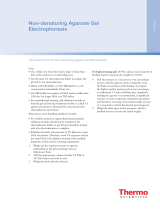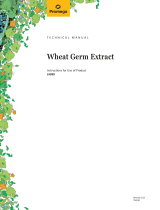Page is loading ...

RiboRuler Low Range RNA Ladder, ready-to-use
Catalog Number SM1833
Pub. No. MAN0013099 Rev. B.00
Contents and storage
Cat. No.
Contents
Amount
Storage
SM1833
RiboRuler Low Range RNA Ladder,
ready-to-use
200 (5 x 40) µL (for 50 applications)
-70 °C or at -20 °C (up to 6 months)
2X RNA Loading Dye
1 mL
Description
Thermo Scientific™ RiboRuler™ Low Range RNA Ladder,
ready-to-use, is premixed with the RNA Loading Dye and can
be directly applied on both the native or denaturing agarose
gels. It is a mixture of seven chromatography-purified single-
stranded RNA transcripts (in bases): 1000, 800, 600, 400,
300, 200 and 100. The ladder is designed for qualitative and
quantitative analysis of RNA on agarose gels stained with
ethidium bromide or SYBR™ Green II.
The ladder is free of degraded RNA and NTP’s. Therefore,
spectrophotometric measurements provide accurate values
of RNA concentration in each ladder band. Due to this
feature, the RiboRuler™ RNA ladder can be used for
approximate RNA quantification on gels.
The RiboRuler™ Low Range RNA Ladder, ready-to-use, is
recommended for electrophoresis in the following: native 2
% agarose with TAE buffer, denaturing formaldehyde
agarose with MOPS buffer, denaturing glyoxal/DMSO
agarose with sodium phosphate buffer and denaturing
polyacrylamide gel electrophoresis in TBE buffer (see RNA
electrophoresis protocols on www.thermofisher.com).
Storage in Loading Buffer
47.5 % formamide, 0.0125 % SDS, 0.0125 % bromophenol blue,
0.0125 % xylene cyanol FF, 0.0125 % ethidium bromide,
0.75 mM EDTA.
2X RNA Loading Dye
95 % formamide, 0.025 % SDS, 0.025 % bromophenol blue,
0.025 % xylene cyanol FF, 0.025 % ethidium bromide,
0.5 mM EDTA.
RiboRuler™ Low Range RNA Ladder, ready-to-use
For Research Use Only. Not for use in diagnostic procedures.
WARNING! Read the Safety Data Sheets (SDSs) and follow the handling instructions. Wear appropriate protective eyewear, clothing, and gloves. Safety Data
Sheets (SDSs) are available from thermofisher.com/support..

RECOMMENDATIONS FOR USE
Note
RNA ladders, as any RNA, are extremely sensitive to degradation by ribonucleases. To avoid RNA degradation, use
protective gloves and prepare fresh gels and electrophoresis buffers just before use. Plastic ware, tips and solutions should
be treated with diethyl pyrocarbonate.
Use the supplied 2X RNA Loading Dye for the preparation of the sample. Mix equal volumes of the 2X RNA Loading Dye
and RNA sample, heat at 70 ºC for 10 min, chill on ice and load. The dye (#R0641) is also available separately.
Loading of equal volumes of the sample and the ladder is recommended. The required volumes can be obtained by diluting
samples with the 2X RNA Loading Dye Solution and Water, nuclease-free (#R0581).
The 2X RNA Loading Dye contains a denaturing agent formamide. When samples are treated with this agent, RNA
molecules separate according to their size both on native and denaturing agarose gels.
For more precise RNA analysis and for Nothern blots, denaturing electrophoresis is recommended.
I. Loading on gel*
Use a 0.5 µL aliquot of the RNA ladder per 1 mm of the gel lane width.
Thaw the ladder on ice.
Mix the contents well by pipetting or by gentle vortexing, as concentration gradients may form in frozen products over time.
Vortex briefly and spin down.
Heat at 70 ºC for 10 min. Chill quickly on ice and load on gel.
* The probe is suitable for electrophoresis both in native agarose with TAE buffer, and in denaturing formaldehyde agarose with MOPS buffer. To prepare
probes for electrophoresis in glyoxal/DMSO agarose with sodium phosphate buffer, see the protocol on www.thermofisher.com
II. RNA visualization
The 2X RNA Loading Dye allows for RNA visualization without additional staining of denaturing agarose gels. If RNA
fragments are separated on native agarose gels, additional staining with ethidium bromide is recommended.
When visualizing a gel under UV light, an additional dark zone of ethidium bromide can sometimes be observed. However,
this has no influence on the quality of RNA separation.
Avoid long exposure to the UV light, as this may cause RNA degradation.
For Northern blots, perform electrophoresis in denaturing formaldehyde agarose with MOPS buffer. A 4 µL aliquot of the
RiboRuler™ RNA ladder is well visible after being transferred on Hybond-N+ membrane from 2 % formaldehyde gel, whereas
the same amount of RNA ladder is less visible when transferred from 2 % native agarose.
The ethidium bromide present in the sample and/or in the gel does not interfere neither with the RNA transfer onto the
membrane, nor with RNA hybridization with the probe.
Limited product warranty
Life Technologies Corporation and/or it affiliate(s) warrant their products as set forth in the Life Technologies’ General Terms and Conditions
of Sale at www.thermofisher.com/us/en/home/global/terms-and-conditions.html. If you have any questions, please contact Life
Technologies at www.thermofisher.com/support.
The information in this guide is subject to change without notice.
DISCLAIMER: TO THE EXTENT ALLOWED BY LAW, THERMO FISHER SCIENTIFIC INC. AND/OR ITS AFFILIATE(S) WILL NOT BE LIABLE FOR SPECIAL, INCIDENTAL, INDIRECT,
PUNITIVE, MULTIPLE, OR CONSEQUENTIAL DAMAGES IN CONNECTION WITH OR ARISING FROM THIS DOCUMENT, INCLUDING YOUR USE OF IT.
Important Licensing Information: These products may be covered by one or more Limited Use Label Licenses. By use of this product, you accept the terms and conditions of all
applicable Limited Use Label Licenses.
©2019 Thermo Fisher Scientific Inc. All rights reserved. All trademarks are the property of Thermo Fisher Scientific and its subsidiaries unless otherwise specified.
hermofisher.com/support | thermofisher.com/askaquestion
thermofisher.com
Thermo Fisher Scientific Baltics UAB | V.A. Graiciuno 8, LT-02241 Vilnius, Lithuania
For descriptions of symbols on product labels or product documents, go to thermofisher.com/symbols-definition.
30 October 2019
/













